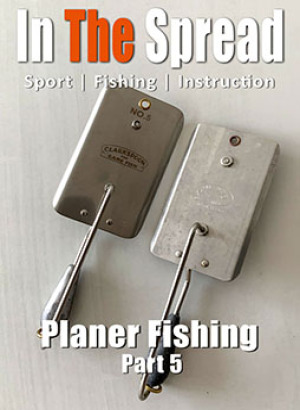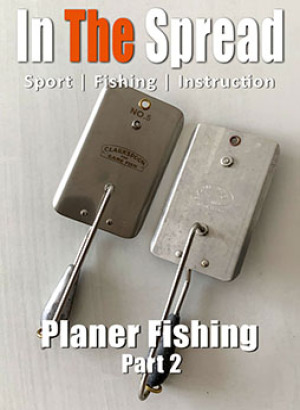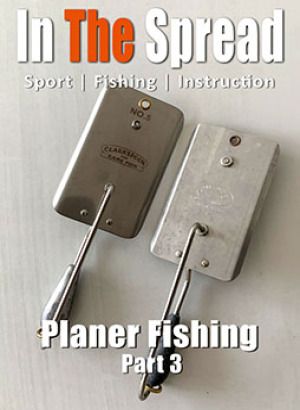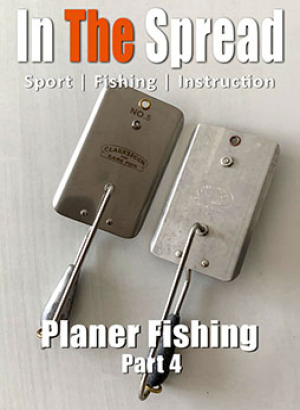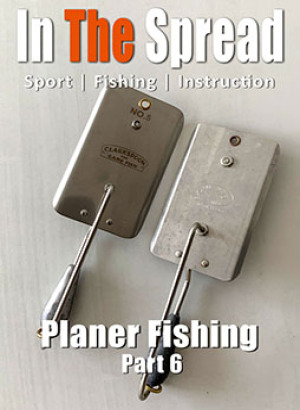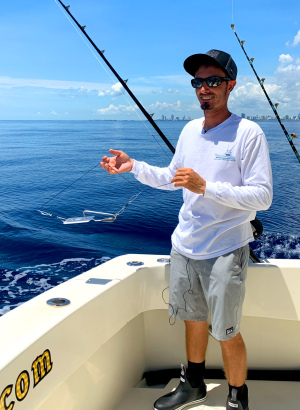Planer fishing is a valuable method for catching suspended fish, which are influenced by environmental factors such as water temperature and availability of food. These fish species adjust their positions in the water column, relying on comfort and food. In summer, warmer surface waters push fish deeper, while lack of dissolved oxygen pushes them upward, creating a narrow comfort band for them to occupy.

Planer Fishing - Target Suspended Fish
A fishing planer allows you to control the depth at which a bait or lure is presented in the water. Unlike weights or sinkers which directly attach to the fishing line and take the bait straight down, a planer is designed to dive deeper as the boat moves forward, pulling the bait down with it in a more controlled and horizontal manner.
The key purpose of a planer is to enable the bait to reach a desired depth while still maintaining a significant distance from the boat. This is particularly useful when targeting species of fish that swim or feed at specific depths, but are easily spooked by the proximity of the boat or are found in deeper waters.
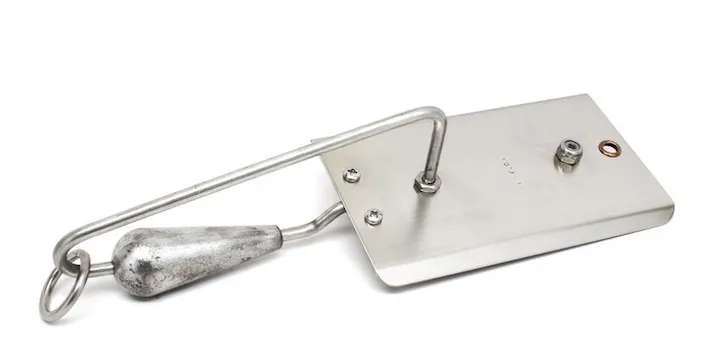
Suspended Fish
Planer fishing is perhaps the best method for reaching suspended fish. What is a suspended fish, you may ask? It is a straightforward answer. Environmental factors require a whole host of fish species to adjust their position in the water column or suspend at a given depth. You see this in both freshwater fishing and saltwater fishing. The larger freshwater apex predators like muskie, pike, bass, trout and saltwater predators like wahoo, mackerel, snook, billfish are well known for situating themselves at a depth range and not moving. There are two main forces at play that determine where fish will suspend. It comes down to comfort and food. Water temperature and the availability of forage food exert tremendous pressure on a wide variety of fish species.
The main driver in all of this is food. The maxim is simple. Find the food and you will find the predator fish we all want to catch. Baitfish are keenly sensitive to water temperature, as are the foundations of the food chain, plankton. Movements up and down in the water column are determined by the creation of water temperature induced comfort zones and the amount of available light penetrating the water, which facilitates the congregation of plankton. Water temperature affects the amount of dissolved oxygen in the water, which is what fish breath. In the saltwater realm, squid and tiny fish follow the plankton blooms up and down and that is where you will find the bigger predators.
One thing is for sure, the species we all like to catch and eat are on the move, in pursuit of their mobile kitchen. With water temperatures and light ever changing, finding the location of that kitchen can be tricky. Understanding this principle is critical in the summer months as the upper level surface water heats up, decreasing the amount of dissolved oxygen. This forces everything down in the water column. There will be a balance though. As the warming surface waters push the fish deeper, the lack of dissolved oxygen at depths pushes them upward, creating a narrow comfort band for the fish to occupy and for you to target. In this scenario, if your trolling your ballyhoo or strip baits on the surface, you may not catch much of anything unless you are out at sunrise of sunset. During the heat of the day, you will need to get your presentations down where the fish are suspended. How do you get your baits down 10, 20, 30 or even 40 feet in the water column, where the fish are, and keep them there, while you troll around? Fishing planers are the answer.
None of this is to say that planers do not have a place in colder months, because they do. October to thru February is wahoo time. Many fishermen run planers to slow troll for wahoo, as the wahoo tend to suspend further down. So, if you want more wahoo bites, try running baits deeper. For this article, we are focusing on the warmer months of summer.
With the looming onset of summer, the days begin to grow longer and the temperature of the water increases. During the daylight hours, fish go deeper in the water column where the oxygen content is higher. Trolling seems to be ubiquitous in the summer months. Many anglers are almost programmed to drop a couple of baits back and troll around waiting for a bite. When it's hot out, they may be trolling the nearshore waters a long time without getting a bite.
Planer Fishing
Trolling baits or lures is one of the easier fishing methods. I mean when you think about it, what could be easier than dropping a couple of baits in the water and cruising around? Sure, you will catch a fish or two, but if you really want to stack some fish in your cooler, target the suspended fish. Planer fishing is the single best option for near-shore and offshore trolling from North Carolina down and around to Texas, in hot weather. Planer fishing is deadly for kingfish, wahoo, bonito and blackfin tuna. You will even hook sailfish, marlin and bigger tuna, at times.
Trolling fishing planers allows to you to present live, natural and artificial bait deep in the water column, where larger predators are stalking baitfish. The fact that charter boats up and down the coast make a living planer fishing should tell you all you need to know. They work and work effectively. You can pull planers over a wide range of trolling speeds, from slow-trolling with natural or dead baits to pulling artificial lures up to 15 mph.
What is a Fishing Planer
From a basic perspective, a fishing planer is just a hydrofoil. A hydrofoil is simply a lifting surface, or foil, that operates in water, but instead of lifting up, it dives down in the water when pulled. A lead weight acts as a keel to keep the planer running straight at a desired depth. When the planer is in the water in diving position, water pressure against the blade forces the planer down. When a fish strikes, the planer is tripped and the balance is changed. The planer then produces a slight upward movement, which allows you to fight your fish rather than the heavy drag created by the engaged planer.
Fishing planers are tough on gear, tending to eat-up line as the braid moves through the rod guides under constant pressure, so it's a good idea to routinely check for frayed or worn line and cut it back as needed. Lighter drag systems can also be devoured by the intense heat created by pulling planers through the water. So, you really want to go with a stout rod and reel that has a more robust drag. The larger the size of the planers you are fishing, the heavier or hardier your tackle should be.
Planer Sizes
Planers come in many sizes ranging from small to extra large. Though boat speed is certainly part of the equation, planer size will dictate how deep your bait will run. Generally speaking, the larger the planer, the deeper your bait will get. Keep in mind that the bigger planers require heavier tackle because they create more drag in the water.
The number on the planer represents the weight, not the actual dimensions of the planer, but rather the weight. Here are some general guidelines for planer size relative to species. You can certainly use whatever size you want. The depth of the fish will determine your planer size. For species like bonito and blackfin #1 planers work well. When targeting king mackerel, #2 and #3 planers are a good starting point. With wahoo, planer sizes will vary from #4, #6 and #8 and far bigger, depenind on the depth where you mark suspended fish.
Planer Fishing Basics
If you are interested in learning more about the fundamentals of planer fishing, have a look at our selection of planer fishing videos located in the Saltwater Fishing Techniques section of our site. Here you will learn about how planers work, how to rig planers, rods and reels, how to engage and trip planers, boat driving while pulling planers and tons of techniques associated with planer fishing.
Fishing with planers should be apart of your basic fishing skill set. It is really pretty easy, once you practice it a few times. Knowing how to effectively fish with planers will instill you with the confidence to go out and boat fish when others are struggling. Understanding why fish suspend and how to present baits to them is fundamental to all types of fishing. Get the knowledge you need and fish smarter.



